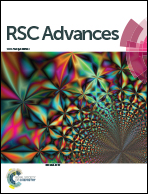In situ growth of Ag/Ag2O nanoparticles on g-C3N4 by a natural carbon nanodot-assisted green method for synergistic photocatalytic activity†
Abstract
Novel visible-light-driven Ag/Ag2O@g-C3N4 (AAC) hybrid materials were synthesized successfully via a green, facile hydrothermal treatment approach by reducing AgNO3 using carbon nanodots as reducing agent for the first time. Natural leaves were used as precursors to prepare carbon nanodots. By adjusting the feed mass ratio of AgNO3 to carbon nanodots, the average diameter of Ag/Ag2O can be modulated from 8 to 33 nm. The effects of Ag/Ag2O deposition on the optical and photocatalytic performance of AAC in the degradation of rhodamine B (RhB) under visible light irradiation were systematically investigated. It was found that the Ag/Ag2O content greatly influences the photocatalytic activity of AAC nanocomposites. A suitable amount of Ag/Ag2O in the AAC system could obtain the best photocatalytic activity. The experimental results indicated that all the AAC nanocomposites showed higher photocatalytic activities compared with that of pure g-C3N4. The remarkable visible-light photocatalytic activity of AAC heterostructures could be attributed to their absorption in the visible region and low recombination rate of the electron–hole pairs because of the heterojunction formed between Ag2O and g-C3N4. In addition, Ag nanoparticles are believed to play an essential role in affecting the photoreactivity because they are able to trap electrons, further separate the electron–hole pairs, and prolong the life of electron–hole pairs. In other words, it can be concluded that the increased photocatalytic activity of AAC was attributed to the synergic effect between g-C3N4, Ag2O and Ag. It is believed that the present work could render useful information for steering the design and application of noble nanoparticle loaded g-C3N4-based heterojunction composites with high photocatalytic activity.


 Please wait while we load your content...
Please wait while we load your content...